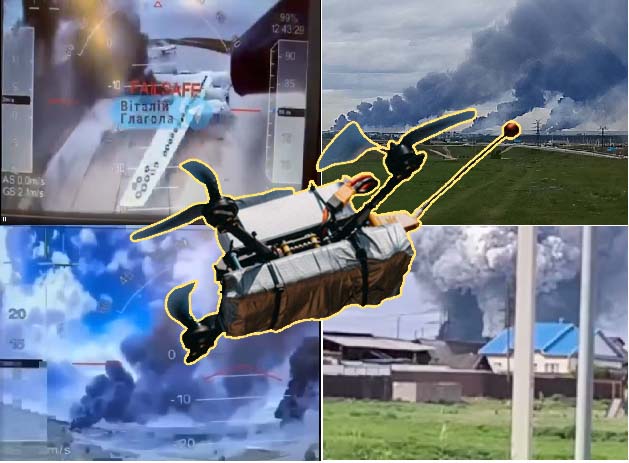
- Russian media have described yesterday’s development as a ‘Pearl Harbour’ moment for Russia, and the Russian Ministry of Defence has admitted that key military infrastructures and bases have suffered significant damage.
- It has been reported that more than 30% of Russia’s long-range, nuclear-capable bombers, such as the Tu-95, have been destroyed, costing Russia more than $2 billion in military losses.
- Since the operation had been planned for the last 18 months, all of these drones were pre-positioned covertly inside Russia, and were stored in remote wooden houses and controlled from a remote location.
- This operation was strategically well-planned and required significant technological support, as the question arises: Can Ukraine execute such an operation alone?
A significant development has occurred in the Russia-Ukraine war, arguably one of the biggest since the very start of the conflict. Ukrainian low-cost FPV drones have launched a surprise and unprecedented attack on key Russian military infrastructures, including major air bases that were considered fortresses of the Russian military. These bases have been severely damaged. In addition to that, Russia’s nuclear submarine bases were also targeted. Russian media have described yesterday’s development as a “Pearl Harbour moment” for Russia, and the Russian Ministry of Defence has admitted that key military infrastructures and bases such as:
- Olenya Air Base in the Murmansk Region
- Belaya Air Base in the Irkutsk Region
- Ivanovo Air Base in the Ivanovo Region
- Dyagilevo Air Base in the Ryazan Region
All these bases have suffered significant damage.
It has been reported that more than 30% of Russia’s long-range, nuclear-capable bombers, such as the Tu-95, have been destroyed, costing Russia more than $2 billion in military losses. The Ukrainian Security Service (SBU) has claimed responsibility for the attack and named the operation “Operation Web.” Following the attack, President Zelensky himself made a statement, calling it a significant Ukrainian strike against Russia, adding that Ukraine had been planning this operation for the last 18 months. It was executed using 117 FPV drones, with drone operators working across three different Russian time zones. Zelensky also confirmed that all drone operators had been safely extracted from Russia and returned to Ukraine.
This is a major intelligence and security breach inside Russia. The bigger question that emerges is: how were these drones launched from within Russia? The answer is quite revealing. Since the operation had been planned for the last 18 months, all of these drones were pre-positioned illegally inside Russia. They were stored in remote wooden houses and controlled from a remote location. Yesterday, these drones were taken out of the houses, loaded onto trucks, and moved near five strategic Russian air bases. The drones were then launched directly from the trucks, which self-destructed soon after.
This operation was strategically well-planned and required significant technological support. The question arises: can Ukraine execute such an operation alone? Given Ukraine’s military capacity, it is difficult to believe that it could do this independently. There should be no doubt that NATO and the United States were deeply involved. Reports have already surfaced that the United States was informed by the Ukrainian government about the upcoming attack.
This could not have been possible without Ukrainian sympathisers within Russia and, more importantly, Russian insiders working against their government. According to reports, the owner of the wooden house was paid \$5,000 to store the drones. This represents a massive intelligence failure and demonstrates how deeply Ukraine has penetrated Russian military intelligence.
For President Putin, this poses a major challenge. This is not the first time that significant military escalations or internal sabotage have occurred. We saw it last year during the attack on Crocus City Mall in Moscow, where Tajikistan-based terrorists were allowed to enter Russia. We have also witnessed repeated sabotage attacks on the Crimean Bridge and in the regions of Bryansk, Belgorod, and Kursk. These incidents would not have been possible without internal Russian support.
This reflects a growing challenge for President Putin. Many within Russia, both civilians and elements of the military, are increasingly discontent. Some political observers, such as Alexander Beglov, have repeatedly argued that Putin should adopt a more authoritarian approach, claiming he is too moderate. Alexander Dugin even stated that the special military operation launched against Ukraine in 2022 should have been initiated years earlier, accusing President Putin of intentionally giving Ukraine time to receive Western military support.
A large section of the Russian population is dissatisfied with the progress of the special military operation, stating that Russia continues to face setbacks and has failed to achieve any major success. Without a doubt, yesterday marked one of the lowest points of President Putin’s presidency since 2000.
More importantly, it raises a fundamental question: should Russia now engage in a full-scale war against Ukraine? A special military operation cannot succeed when the enemy is waging a total war. Russia must recognise that this conflict is no longer about “demilitarisation” or “denazification” alone. It has become a full-scale war between NATO and Russia, with Ukraine serving as NATO’s proxy. Therefore, President Putin must now make decisions under this new reality.
Aayush Pal is a freelance writer on contemporary geopolitical developments. The views expressed in his work are entirely his own.
